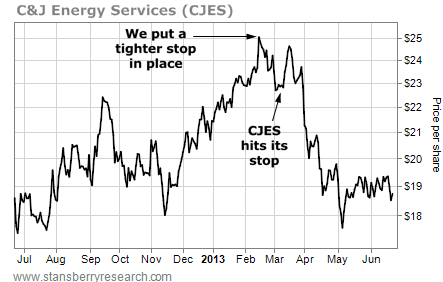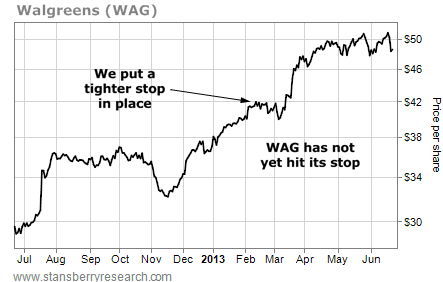Unless you've been hiding under a rock, you're probably well aware of the dangers associated with smoking tobacco and have witnessed the increasing efforts of the Centers for Disease Control and Prevention to step up its educational efforts over the past two decades.
The good news is that the number of smokers in the United States is on the decline, with just 19% of U.S. adults listed as current smokers by the CDC.

Source: Centers for Disease Control and Prevention.
Targeted advertising that's graphic, educational, and focused on America's youth has instilled the dangers of smoking into much of the younger generation. The CDC, for example, kicked off its first-ever anti-smoking television campaign last year, spending $54 million over the course of three months with the express purpose of causing at least 50,000 people to quit.

Source: Linus Bohman, Flickr.
The reason to encourage smokers to quit is much more than "it's just bad for you"; scientifically and economically it's been shown that smoking can affect our friends and family and harm productivity in the workplace. Secondhand smoke, for instance, has been shown to increase the probability that our friends and family will develop a disease directly caused by cigarette smoke inhalation. In addition, U.S. businesses lose about $97 billion in productivity each year because of disease-related complications caused by cigarette smoking. Keep mind this figure is just based on productive work-lives shortened by cigarette smoking and doesn't include lost production because of disability and sick days.
However, nothing stands out as more glaring than the deaths that are directly attributable to cigarette smoking -- an average of 443,000 annually between 2000 and 2004, according to the CDC. Today I propose to examine the three most deadly diseases caused by cigarette smoking and analyze what medications are available to help treat those diseases.
Cancer
This is something of a no-brainer, but cancer was responsible for 164,200, or 37%, of the total deaths attributable to cigarette smoking. If you recall, smoking was practically a universal risk factor across the board when I examined the 12 most commonly diagnosed cancers in the Tackling Cancer series earlier this year.
Of the attributed smoking deaths associated with cancer, none is more virulent than lung cancer which singlehandedly claimed an average of 128,900 lives annually between 2000 and 2004. Based on the CDC's statistics, the risk of developing lung cancer by smoking cigarettes increases by a factor of 23 for men and 13 for women relative to non-smokers, while five-year survival rates for lung cancer sit at just a dismal 12%.
Perhaps no drug is more widely used in lung cancer treatment than Roche's Avastin. Roche's wonder drug is an angiogenesis inhibitor, simply meaning that it inhibits the growth of blood vessels to tumors in the hope of starving a solid tumor of the oxygen needed for it to grow. When Avastin was approved in 2006, it improved median overall survival in patients to 12.3 months from 10.3 for the control arm. Relatively speaking, though, we need to do a lot better than just 12.3 months!
The next step in lung cancer care treatment may come from the likes of Bristol-Myers Squibb's nivolumab or Merck's (NYSE: MRK ) lambrolizumab. Both of these drugs are known as PD-1 inhibitors which have shown reasonably high overall response rates in clinical trials – 40% for nivolumab and 38% for lambrolizumab – and could represent the next treatment pathway for lung cancer patients. Nivolumab is currently in six in late-stage trials, including the treatment of non-small-cell lung cancer, while Merck's lambrolizumab has received the rare breakthrough therapy designation from the FDA, which could help streamline its approval if it continues to provide a huge statistical benefit in trials over existing treatments.
Ischemic heart disease
Closely trailing cancer as the most deadly smoking-related cause of death is ischemic heart disease, which was responsible for 126,000, or 28%, of all deaths. Ischemic heart disease is a condition in which the heart doesn't receive enough blood flow, which can be caused by a number of factors, including high blood pressure (hypertension), high cholesterol, and diabetes. Once again, and as no surprise, smoking is a major risk factor for developing all three diseases!
Unlike a cancer diagnosis, which pretty specifically cued in on lung cancer relative to all other cancer diagnoses combined by a margin of greater than 3-to-1, ischemic heart disease can develop as a result of any one, or a combination of, the aforementioned diseases. This means that in addition to quitting smoking, and living an active life with a proper diet, certain medications may be called upon to help regulate a person's cardiovascular system.
Novartis' Diovan, for example, is a widely prescribed treatment for helping patients with high blood pressure. Diovan is an angiotensin II receptor blocker, meaning that it prevents angiotensin from affecting blood vessels, ultimately relaxing them and allowing blood to flow more easily. Although Diovan lost its patent protection last year, no biosimilar version of the drug has made it to market as of yet.
The new kid on the block in treating LDL-cholesterol (the bad type) is Liptruzet, a combination therapy of Pfizer's (NYSE: PFE ) generic Lipitor and Merck's cholesterol absorption inhibitor, Zetia. Separately, these two drugs were effective at reducing LDL-cholesterol levels by 37% to 54%, and 20%, respectively. However, when combined the combination, known as Liptruzet, boosted the LDL-reducing effect to 53%-61%. It looks like the legend of Lipitor, the best-selling drug in history, will live on!
With regard to diabetes, it really just depends whether you're dealing with the genetic and rarer form of the disease, type 1 diabetes, or the much more common type 2 diabetes, whose onset is based on a number of factors that includes diet, activity level, and genetics. For the sake of argument -- and to take nothing away from type 1 diabetes patients, who recently had an encouraging discovery of their own -- Johnson & Johnson's (NYSE: JNJ ) new SGLT-2 inhibitor, Invokana, looks to be the next big thing in type 2 diabetes treatment. Working in the kidneys instead of the liver or pancreas, Invokana allows the body to excrete excess glucose through the urine. Better yet, Invokana has also been shown to induce weight loss (which can be a good thing since a majority of diabetics are overweight) and reduce hypertension.
Chronic obstructive pulmonary disease
Not to be forgotten is chronic obstructive pulmonary disorder, better known as COPD, which was responsible for 92,900, or 21%, of all cigarette smoking-related deaths from 2000 to 2004. COPD is already the third-leading cause of death in the U.S., slightly ahead of stroke, and comes in two primary forms: chronic bronchitis, which is exhibited by a long-term cough with mucus production, and emphysema, an irreversible and progressive degradation of the lungs over time.
Perhaps the most exciting new treatment to hit the market in years was recently approved by the FDA. Developed by GlaxoSmithKline (NYSE: GSK ) and Theravance (NASDAQ: THRX ) , Breo Ellipta is a dry powder drug delivered by inhaler and meant to provide long-term relief of air-flow obstruction and reduce COPD exacerbations. The two companies are collaborating on a handful of potentially revolutionary new COPD treatments that combine Theravance's long-acting beta-2 agonists with Glaxo's long-acting muscarinic antagonists. Its next treatment, Breo Anoro, is currently under review by the FDA.

Source: Centers for Disease Control and Prevention.
The butt of the problem
The negative effects of cigarette smoking on our bodies is quite clear no matter where we look for our evidence. If you choose to smoke, your likelihood of developing one of these three deadly diseases, which were responsible for 86.5% of all smoking-related deaths, is greatly increased.
If we've learned anything here today, it's that quitting smoking could be one of the healthiest and smartest moves you ever make as it could drastically reduce your chances of developing a serious illness, and that tobacco is quite addictive -- otherwise, most people would have stopped smoking a long time ago. This means that while we are seeing a minimal reduction in the percentage of U.S. smokers, the need for medications to treat lung cancer, COPD, and various forms of ischemic heart disease aren't likely to slow anytime soon.
Obamacare will undoubtedly have far-reaching effects. The Motley Fool's new free report "Everything You Need to Know About Obamacare" lets you know how your health insurance, your taxes, and your portfolio could be affected. Click here to read more.
 We moved closer to the exit... and then the market told us it was time to go. While C&J's share price completed a "round trip" back down into the high teens this spring, readers who followed our advice walked away with a 17% gain.
We moved closer to the exit... and then the market told us it was time to go. While C&J's share price completed a "round trip" back down into the high teens this spring, readers who followed our advice walked away with a 17% gain.  Afterward, shares marched higher. Even after the recent market weakness, they're a chip-shot away from a new all-time high. Our readers can continue to make gains here until the market tells them otherwise.
Afterward, shares marched higher. Even after the recent market weakness, they're a chip-shot away from a new all-time high. Our readers can continue to make gains here until the market tells them otherwise. 

